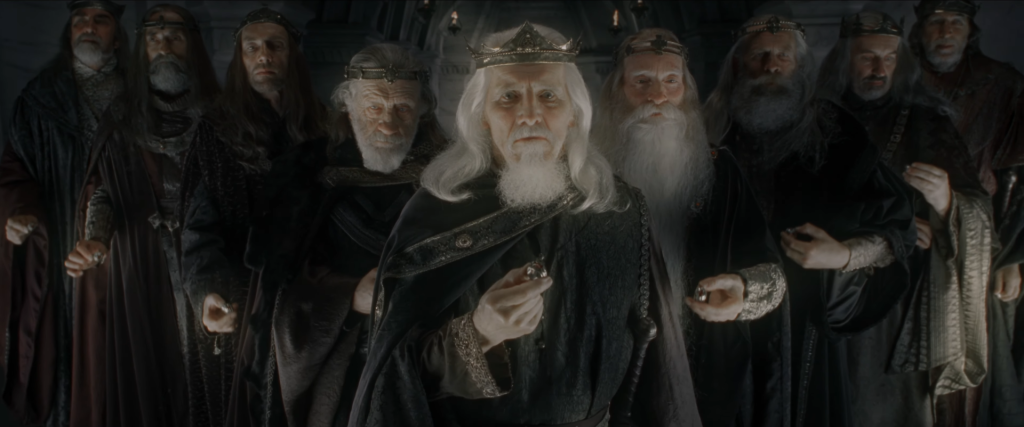On Wednesday, Amazon Studios revealed that . The Rings of Power are well-known artifacts in Middle-earth lore to any longtime Tolkien fans. However, they may not be as familiar to more casual fans who are primarily familiar with Peter Jackson’s film adaptations of Tolkien’s novels. Those films mention the Rings of Power briefly but chiefly concern only the One Ring, the greatest of them all. However, in the Second Age, the Rings of Power were contentious items key to Sauron’s plans to dominate Middle-earth.
Videos by ComicBook.com
The Rings of Power occurs during Middle-earth’s Second Age. This era began after the defeat of Sauron’s master, Morgoth. It ended with Isildur cutting the One Ring from Sauron’s finger, as depicted in the prologue scene that opens Jackson’s The Fellowship of the Ring. Sauron spent approximately the first 500 years of this age in hiding. Then, believing enough time had passed that he’d be safe to act, he began plotting to corrupt the Elves of Middle-earth.

Sauron disguised himself as Annatar, Lord of Gifts, a supposed emissary from the Valar, powerful beings that helped shape Middle-earth. Most of the elves were suspicious of Annatar and rejected him, but he received a warmer welcome in Eregion. Only Galadriel, who ruled the realm alongside her husband Celeborn, suspected Annatar. Still, the Elves of Eregion coveted knowledge, and that’s what Annatar offered them.
Annatar taught the Elven smiths how to forge magic Rings, befriending the greatest among them, Celebrimbor. After creating several lesser Rings to practice and hone the craft, Annatar and Celebrimbor made 16 Great Rings, which separated into two groups known as the Seven and the Nine. After Annatar left to distribute those rings, Celebrimbor alone forged the Three Rings without Annatar’s knowledge. The Elven lords Galadriel, Elrond, and Círdan became the Keepers of the Three Rings.
With Annatar’s work completed, Sauron went to Mount Doom and secretly forged the One Ring, which he could use to bind the other Rings and their wearers to his power. However, the Keepers of the Three Rings, immediately sensing when Sauron put the One Ring on, took their rings off. The Elves refused to use their Rings or return them to Sauron, who sought to gift them to more pliable peoples of Middle-earth. The Elves hid the rings, which led to the War of the Elves and Sauron.
With the help of the Men of Númenor, the Elves won a decisive victory against Sauron. However, the war caused much destruction, wiping Eregion out entirely. Sauron retrieved the Seven and the Nine during the conflict. He then gifted the Seven to Dwarven lords, who used them to amass great treasure. The Nine he gave to kings of Men who sought power, including some who were already in his allegiance.
Sauron hoped to corrupt them all, but the Dwarves proved resistant to his power. Men, however, proved susceptible, and eventually, they transformed into the Ringwraiths, some of Sauron’s most fearsome minions.
Having failed to bring most of Middle-earth’s peoples under his control through guile, Sauron amassed an army and made open conquest. The Last Alliance of Elves and Men fought back against Sauron. The war led to Númenor’s demise, but ultimately the Last Alliance laid siege to Sauron’s tower, Barad-dûr. Isildur severed Sauron from the One Ring, ending the war and closing out the Second Age.
Before his defeat, Sauron had already reclaimed the Nine from the Ringwraiths, who were already entirely under his spell. The Nine remained in Sauron’s possession until his final defeat at the end of the War of the Ring. Sauron also reclaimed three of the Seven. Dragons had melted the other four during their conflicts with the Dwarves. Sauron would later offer to return the surviving Rings to the dwarves for assistance in searching for the One Ring. The Dwarves knew better than to ally themselves with the Dark Lord by then.
The Keepers of the Three Rings used their power to slow the passage of time in their realms, keeping their forest domains lush and green. Upon the One Ring’s destruction, the rings lost their power. The Keepers left Middle-earth, and their realms faded.
The story of the Rings of Power is but one tale of the Second Age of Middle-earth, but it is one full of deceit, betrayal, and eventually, war. It isn’t hard to see why Amazon Studios chose it as the basis for the new series.
Are you excited about The Lord of the Rings: The Rings of Power? Let us know in the comments. The Lord of the Rings: The Rings of Power will premiere on September 2nd on Prime Video.









